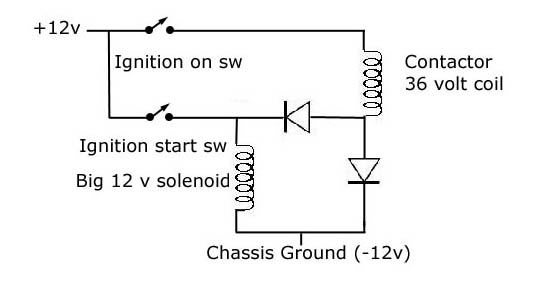
Using a 24-36 volt contactor on 12 volts
 |
Lee Hart's Contactor Pulser Using a 24-36 volt contactor on 12 volts |
You need a couple of diodes, such as 1N4001 type. You also need a big 12v solenoid coil, something like an old Ford starting solenoid, about twice the size of the coil on the contactor you wish to use.
Here's the circuit:

How it works: S1 and S2 are your ignition keyswitch, with an on switch S1 and start switch S2. When
you turn the key to the start position, both S1 and S2 close. S1 powers all your 12v stuff, and the high side of the 36v
contactor. The low end of the 36v contactor goes to ground through diode D2. The contactor coil has about 11v across it -
not enough to pull it in.
Meanwhile, S2 is also closed. It pulls in the big 12v solenoid. This solenoid can do something mechanical like operate a switch to do your controller or DC:DC precharge, or you can just block its plunger so it doesn't move or make any noise. It doesn't matter. We're only using the solenoid for its inductance.
Diode D1 is reverse-biased, so it does not conduct. The solenoid's current ramps up to whatever its coil resistance allows; it should be 2 or 3 times as much as the 36v contactor's normal current on 36v.
Now you release the key so it springs back to the "run" position. S1 stays closed, but S2 opens. The inductance of the solenoid insists that current keep flowing in the circuit. So the voltage on its high side goes strongly negative (below ground). This forces D1 to conduct and D2 to get reversed biased. The low side of the 36v contactor pulls way below ground.
Now the 36v contactor has over 36v! The current in it is forced up by the solenoid current. The pulse will last until the energy stored in the big coil has dissipated.
As long as the solenoid coil is bigger and stores more energy than the contactor coil, it wins and the contactor pulls in. Once pulled in, the 36v contactor stays pulled in just with the 12v from S1 through D1. The big solenoid drops out.
Dirt simple, and no electrolytic capacitors or relays, so it should be very reliable. The big solenoid can be a cheap one built for intermittent duty, as it is only powered for a second or so.